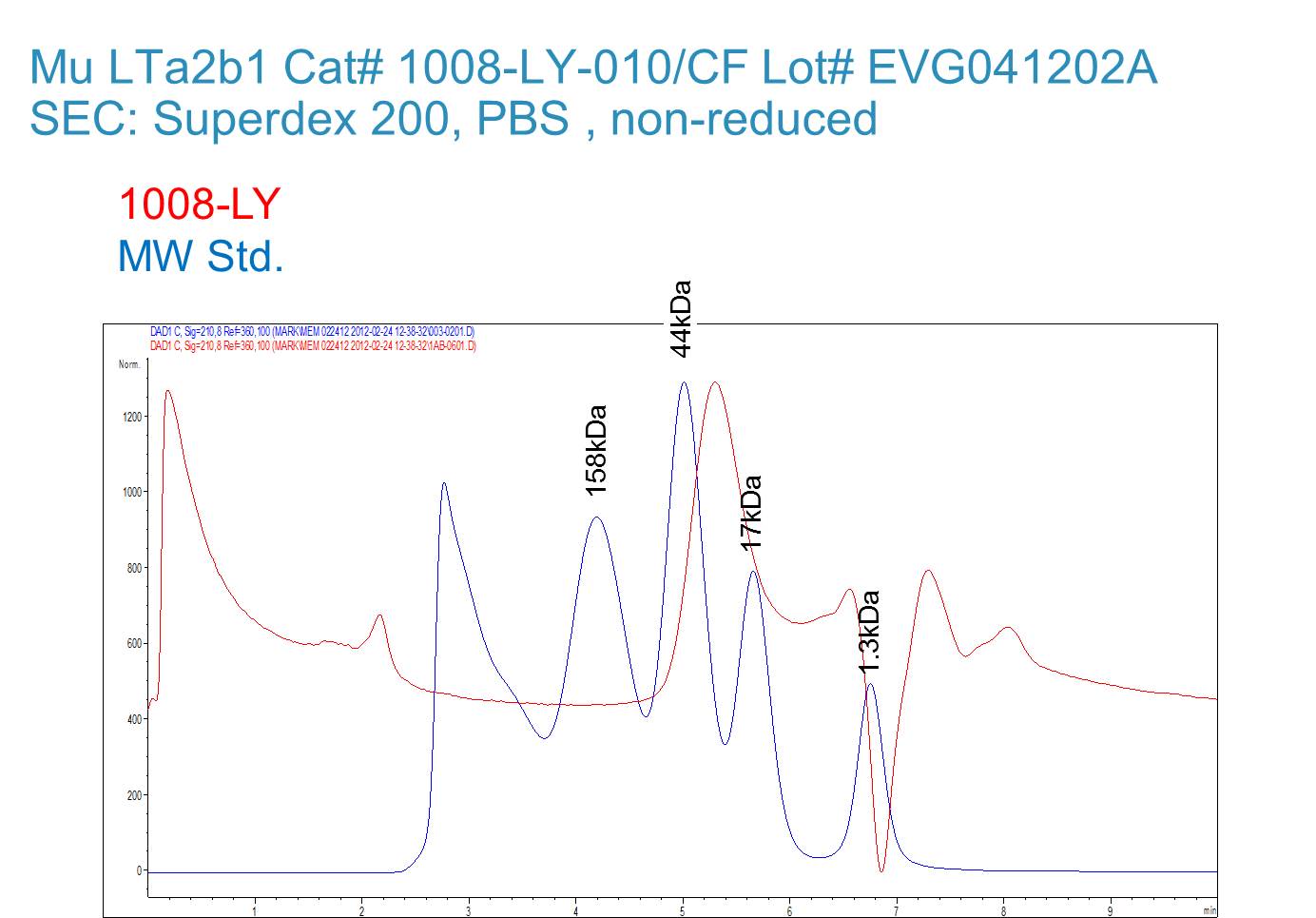Recombinant Mouse Lymphotoxin alpha2/beta1 Protein Summary
Product Specifications
Leu34-Leu202 (LT alpha ) & Gly136-Gly306 (LT beta )
Analysis
Product Datasheets
Carrier Free
CF stands for Carrier Free (CF). We typically add Bovine Serum Albumin (BSA) as a carrier protein to our recombinant proteins. Adding a carrier protein enhances protein stability, increases shelf-life, and allows the recombinant protein to be stored at a more dilute concentration. The carrier free version does not contain BSA.
In general, we advise purchasing the recombinant protein with BSA for use in cell or tissue culture, or as an ELISA standard. In contrast, the carrier free protein is recommended for applications, in which the presence of BSA could interfere.
1008-LY
| Formulation | Lyophilized from a 0.2 μm filtered solution in PBS with BSA as a carrier protein. |
| Reconstitution | Reconstitute at 10 μg/mL in sterile PBS containing at least 0.1% human or bovine serum albumin. |
| Shipping | The product is shipped at ambient temperature. Upon receipt, store it immediately at the temperature recommended below. |
| Stability & Storage: | Use a manual defrost freezer and avoid repeated freeze-thaw cycles.
|
1008-LY/CF
| Formulation | Lyophilized from a 0.2 μm filtered solution in PBS. |
| Reconstitution | Reconstitute at 100 μg/mL in sterile PBS. |
| Shipping | The product is shipped at ambient temperature. Upon receipt, store it immediately at the temperature recommended below. |
| Stability & Storage: | Use a manual defrost freezer and avoid repeated freeze-thaw cycles.
|
Reconstitution Calculator
Background: Lymphotoxin
Lymphotoxin-alpha (LT alpha ), also known as tumor necrosis factor (TNF) beta, and lymphotoxin-beta (LT beta ) are members of the TNF family. LT alpha cDNA encodes a 202 amino acid (aa) secreted soluble protein with a 33 aa signal sequence. LT beta cDNA encodes a 306 aa type II membrane protein with an N-terminal cytoplasmic domain (residues 1 - 18), a transmembrane region (residues 29 - 48), and an extracellular domain (residues 49 - 306). Secreted LT alpha assembles as a soluble homotrimer, LT alpha 3. In addition, secreted LT alpha also complexes with the membrane associated LT beta to generate two types of heterotrimers, LT alpha 1/ beta 2 and LT alpha 2/ beta 1 (1). The soluble LT alpha 3 binds both TNF RI (p55) and TNF RII (p75). In contrast, the predominant membrane-bound heterotrimer, LT alpha 1/ beta 2, binds only to the lymphotoxin beta receptor (LT beta R). LT alpha 2/ beta 1 is capable of binding LT beta R, TNF RI (p55), and TNF RII (p75). LT plays a role in normal lymphoid organogenesis (2, 3). Transgenic LT alpha knock-out mice exhibited a loss in lymph node development, a change in splenic architecture, and impaired germinal center formation (4). LT is expressed by activated naïve CD4 cells, unpolarized IL-2-secreting effectors, and Th1 effectors. A loss of LT expression and lack of TNF-alpha or TNF-beta secretion is associated with prior exposure to IL-4 and a Th2 phenotype (5).
- Browning et al. (1993) Cell 72:847.
- Ettinger et al. (1996) Proc. Natl. Acad. Sci. USA 93:13102.
- Cuff et al. (1998) J. Immunol. 161:6853.
- Browning et al. (1997) J. Immunol. 159:3288.
- Gramaglia et al. (1999) J. Immunol. 162:1333.
Citations for Recombinant Mouse Lymphotoxin alpha2/beta1 Protein
R&D Systems personnel manually curate a database that contains references using R&D Systems products. The data collected includes not only links to publications in PubMed, but also provides information about sample types, species, and experimental conditions.
2
Citations: Showing 1 - 2
Filter your results:
Filter by:
-
TNF superfamily member, TL1A, is a potential mucosal vaccine adjuvant.
Authors: Kayamuro H, Yoshioka Y, Abe Y, Katayama K, Yoshida T, Yamashita K, Yoshikawa T, Hiroi T, Itoh N, Kawai Y, Mayumi T, Kamada H, Tsunoda S, Tsutsumi Y
Biochem. Biophys. Res. Commun., 2009-05-04;384(3):296-300.
Species: Mouse
Sample Types: In Vivo
Applications: In Vivo -
A contrast agent recognizing activated platelets reveals murine cerebral malaria pathology undetectable by conventional MRI.
Authors: von Zur Muhlen C, Sibson NR, Peter K, Campbell SJ, Wilainam P, Grau GE, Bode C, Choudhury RP, Anthony DC
J. Clin. Invest., 2008-03-01;118(3):1198-207.
Species: Mouse
Sample Types: In Vivo
Applications: In Vivo
FAQs
No product specific FAQs exist for this product, however you may
View all Proteins and Enzyme FAQsReviews for Recombinant Mouse Lymphotoxin alpha2/beta1 Protein
Average Rating: 4 (Based on 1 Review)
Have you used Recombinant Mouse Lymphotoxin alpha2/beta1 Protein?
Submit a review and receive an Amazon gift card.
$25/€18/£15/$25CAN/¥75 Yuan/¥2500 Yen for a review with an image
$10/€7/£6/$10 CAD/¥70 Yuan/¥1110 Yen for a review without an image
Filter by:
Reason for Rating: Data shows that one peak is observed to elute off the SEC. The peak elutes between the 17kDa & 44kDa MW standards. The MW of this homotrimer is 55536Da and should run after the 44kDa MW standard.




